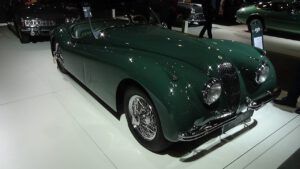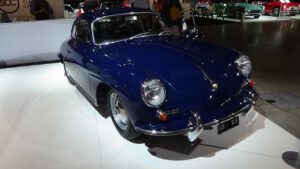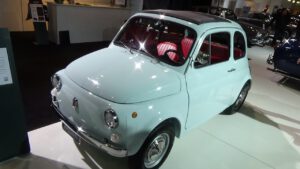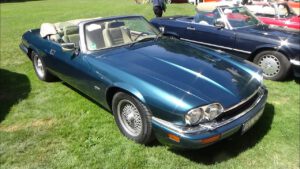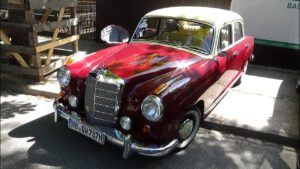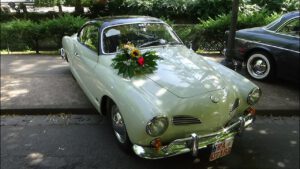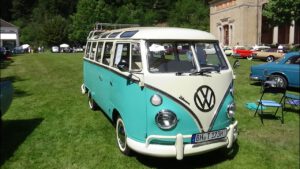Discover the captivating world of cars in literature. From “The Great Gatsby” to “On the Road”: Automobiles have played an integral role in books. Metaphor for escape, freedom and liberation, symbol of a new beginning or sexual fetish: Dive into iconic stories driven by unforgettable cars.
Gatsby’s Rolls-Royce: The American Dream and tragedy in Fitzgerald’s masterpiece
In “The Great Gatsby” by Scott Fitzgerald, a cream-coloured Rolls-Royce serves as a symbol of the fact that the main character, a mysterious upstart, wants to gain a foothold in the sophisticated New York world of the 1920s. Fitzgerald devotes a detailed description to Gatsby’s magnificent yellow Rolls-Royce. Nick Carraway narrates his first ride with Jay Gatsby in his car:
“He saw me looking with admiration at his car. ‘It’s pretty, isn’t it, old sport?’ He jumped off to give me a better view. ‘Haven’t you ever seen it before?’ I’d seen it. Everybody had seen it. It was a rich cream color, bright with nickel, swollen here and there in its monstrous length with triumphant hat-boxes and supper-boxes and tool-boxes, and terraced with a labyrinth of wind-shields that mirrored a dozen suns. Sitting down behind many layers of glass in a sort of green leather conservatory, we started to town.”
For Fitzgerald’s characters, the automobile epitomizes the progress of the American dream. Opulent cars and references to road trips recur throughout the narrative. The pursuit of wealth and status, intrinsic to the American dream, underscores the significance of cars. They embody not only affluence but also a sense of newfound liberation. In the story, Gatsby possesses an opulent car, a luxurious cream-colored Rolls-Royce.
However, Fitzgerald consistently underscores that these grandiose automobiles can be perilous, deceptive, and ruinous. Shortly after his wedding, Tom jeopardizes his own life in a compromising car collision with a maid. Later, while departing Gatsby’s soirée, an inebriated guest wrecks his car, losing a wheel: the man’s ostentatious status symbol exposes him as a feeble-minded individual. Yet, most significantly, it is a recklessly driven car that claims Myrtle’s life, and a misunderstanding about the actual driver of Gatsby’s car ultimately seals Gatsby’s tragic fate.
Commissaire Maigret doesn’t know how to drive
Commissaire Maigret is a famous French detective created by Georges Simenon. He works at the Paris Police Department and is known for being calm, patient, and understanding towards criminals. He enjoys smoking a pipe and appreciates good food. Surprisingly, Maigret doesn’t know how to drive. When he’s in a hurry, he relies on an assistant to chauffeur him around in a black Renault 4CV or Citroën Traction Avant in the 1950s, or a Peugeot 403 in the 1960s. He usually gets around Paris by walking, taking taxis or buses, and rarely uses the metro. In a 1988 TV episode, it’s revealed that Madame Maigret is the one who drives their car.
Peugeot 4CV
Renault 4CV
Citroën Traction Avant
Jack Kerouac’s “On the Road”
“On The Road” by Jack Kerouac exults in the liberation of a road trip and the hopeful belief that there’s always something better waiting elsewhere, even in the most despairing moments. The central figures are the narrator, Sal Paradise, and his intrepid companion, Dean Moriarty, who acts as both an inspiration and a catalyst for Sal’s journeys. The book is structured into five parts, with three of them chronicling road trips alongside Moriarty. It commemorates adventures spanning from the eastern to the western horizon, from the northernmost point to the southernmost, and extending all the way to Mexico.
1947 Cadillac
Cars play an important symbolic role in “On the Road”. They represent the characters’ means of transportation across the country and symbolize the freedom of the open road and the possibility of escaping ordinary life. Sal often fantasizes about driving down the road behind the wheel of a speeding car when he is bored. But at the same time, the state of the cars reflects the exhaustion that traveling inflicts on the characters. Dean drives aggressively and fast, which often results in damage to the cars. The 1947 Cadillac that Dean and Sal drive to Chicago is badly worn and barely recognizable. This deterioration of the car also symbolizes the deterioration of the characters themselves. Just as the cars can only drive to a certain point before they break down, the characters can only endure life on the road for a limited time. Therefore, Sal and Dean return after their trips to recover from the hardships that life on the road inflicts on their bodies.
1937 Ford
During the spring of 1950, Sal once again feels the call to embark on a journey. Meanwhile, Dean is stationed as a parking attendant in Manhattan, sharing a residence with his girlfriend Inez. Opting for bus travel, Sal traverses cities like Washington, D.C., Ashland, Cincinnati, and St. Louis, ultimately reaching Denver. It’s here that he encounters Stan Shephard, leading to their joint plan for a voyage to Mexico City. However, their plans shift upon discovering that Dean has acquired a car and is en route to join them. Together in a weathered 1937 Ford, they venture through Texas, eventually arriving in Laredo, where they cross the border.
“Drive Nacho Drive” by Brad Van Orden
“Drive Nacho Drive” chronicles the journey of Brad and his wife Sheena, who relinquish their jobs, abandon the American dream, and set off southward in their weathered Volkswagen bus affectionately named Nacho. Their odyssey spans the entirety of Central America, spanning the challenging Darien Gap to reach South America, ultimately culminating at the “end of the world” in Patagonia, where the Pan-American Highway comes to an end.
The book provides an amusing yet touching account of Brad and Sheena Van Orden’s decision to exchange the American dream for a year of traversing the roads of Central and South America in the company of their determined and capricious Volkswagen van, Nacho.
As a result of their questionable choices and occasional bouts of misfortune, Brad and Sheena find themselves repeatedly entangled in predicaments. Whether navigating through rebel-infested territories on perilous roads, caught in the act of smuggling a transmission across international borders in a suitcase, embarking on a covert mission to reclaim Nacho from an eccentric Colombian auto recycler, or gripping the side of a vegetable-laden truck as they descend a 16,000-meter-high Andean pass, their challenges appear boundless.
In “Drive Nacho Drive,” the Van Ordens present a reflective, humorous, and engaging account of their adventures and mishaps on the Pan-American Highway – a narrative that will elicit both head-shaking incredulity and hearty laughter, all while prompting the question: Is there not more to life?
“Mr. Mercedes” and his killer car
Stephen King’s “Mr. Mercedes” is about a killer who crashes a stolen Mercedes S Class into a crowd of people, killing eight and injuring many. It’s a classic cat-and-mouse story about a psychopathic killer and the rogue cop who makes it his mission to hunt him down. Retired detective Bill Hodges receives a letter from the killer, who claims to be “Mr. Mercedes”. Hodges investigates together with the victims’ cousin, Holly, and his friend Jerome. They discover Brady’s true identity and plan to thwart his suicide bombing at a concert. However, Hodges suffers a heart attack and is unable to intervene. Holly hits Brady hard in the head with a filled percussion instrument, causing him to fall into a coma.
“Rückwärtswalzer”: 1000 kilometres of Balkan highways, a thawing corpse on the backseat of a Fiat Panda
Lorenz, an unsuccessful actor, is given the job of taking Uncle Willi’s body back to his homeland of Montenegro in a Fiat Panda. The body is disguised as an elderly person sleeping, with three older aunts in the back. The main focus of this book is the journey of the thawing body across 1000 kilometers of Balkan highways. Along the journey, we get to know the history of the Prischinger family from the Waldviertel region of Lower Austria. Three sisters hold a secret, while bear hunters try to stop time. The spirits of the departed are never far from the main characters, whether they want them there or not.
Mirl, the oldest sister, carries a lot of responsibility from a young age after the war. She dreams of leaving her parents’ inn and the countryside behind, but her life in town and her marriage turn out differently than she hoped. Wetti, from a young age, prefers animals to people. She knows the museum specimens inside out and shocks Vienna society as a single mother. Hedi, the youngest of the three, meets Willi at a crucial moment when she’s about to make a big change in her life.
Van Life (“en camping-car”) by Ivan Jablonka
In this captivating blend of autobiography and historical narrative, the pages of Ivan Jablonka’s book unfold like a cherished family album, each chapter a snapshot capturing the essence of a bygone era. Part reminiscence, part exploration of a lost epoch, the narrative spans generations, starting with the author’s own childhood experiences traversing the landscapes of Portugal, Greece, Morocco, and Italy aboard the iconic VW Combi. As the motorhome devours the miles, the author’s formative years unfold, shaped by a nomadic existence where the only imperative is to exist. This autobiographical essay emerges as a heartfelt ode to the nomadic lifestyle, a homage to the school of the road, where life’s lessons are learned amidst the backdrop of changing landscapes.
The VW Combi, more than a mere means of transportation, emerges as a philosophy, a way of contemplating travel that epitomizes the 80s and the liberating road trips under the sun of freedom. The roadtrip is not just a recollection of a teenager’s transformation into a historian but a nuanced portrait of a society that has long faded into the annals of time. The story emerges as a testament to a simpler time, a tale of a blissful family and a father’s unwavering determination to gift his children cloudless skies and an absolute sense of happiness and freedom—a gift he himself was deprived of in his youth. Beneath the sunny and luminous veneer of the narrative, a subtler theme emerges—the obligation to happiness as a counterbalance to the shadows of family history. Ivan Jablonka masterfully interlaces the joy of road-tripping and the poignancy of familial legacies, creating a literary mosaic that resonates with both the warmth of nostalgia and the bittersweet complexities of life’s journey.
Paul Auster’s “The Music of Chance”: a roadtrip, freedom, happiness and a Saab
Jim Nashe, a firefighter dealing with a recent breakup, sends his daughter Juliet to live with his sister. Deciding to pursue a life of freedom, he squanders his fortune on a year-long cross-country journey in a Saab.
He finds himself unattached, he gets lost in his own wandering that he doesn’t even understand himself. He crisscrosses the U.S. by car, meeting unexpected characters appearing out of nowhere.
Facing financial ruin, Nashe teams up with a reckless gambler, Jack Pozzi, to swindle wealthy bachelors, Flower and Stone, in a poker game. Nashe bets his car in a final desperate move. To settle the debt, Nashe and Pozzi are tasked with constructing a wall on Flower and Stone’s property, a venture laden with challenges and crises. Nashe, eventually free, drives his old car again but meets a tragic end in a fatal accident.
This tale of underdogs echoes the tradition of American travel stories, resembling Jack Kerouac’s style but with an ironic twist. It explores the unpredictable nature of happiness and the subjective construction of reality.

